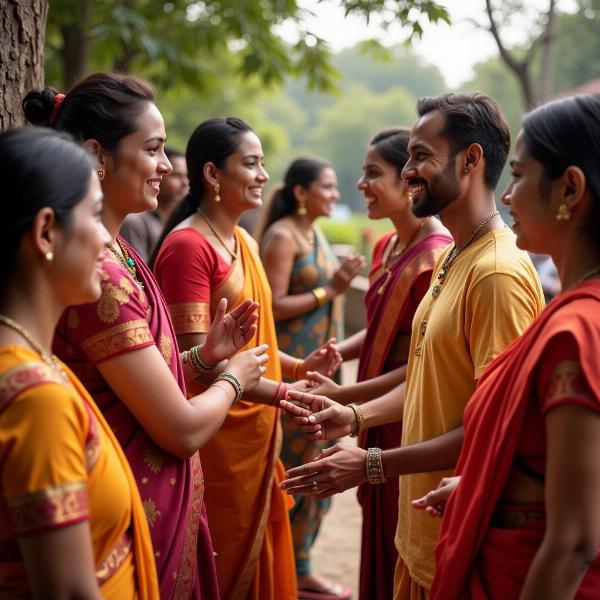Understanding the nuances of “good day” in Hindi enriches your grasp of the language and culture. It’s not just a simple translation, but a glimpse into the Indian way of expressing well wishes and greetings. This article explores various ways to say “good day” in Hindi, delving into their cultural context and usage.
Different Ways to Say “Good Day” in Hindi
While there isn’t a single, direct equivalent of “good day” used throughout the day in Hindi, several phrases convey similar sentiments depending on the time of day and context. Let’s explore some common expressions:
- Suprabhat (सुप्रभात): This is the formal equivalent of “good morning.” Used primarily in written communication or formal settings, it carries a respectful tone.
- Shubh Prabhat (शुभ प्रभात): Another formal way to say “good morning,” often used in speeches or announcements.
- Namaste (नमस्ते): Perhaps the most well-known Hindi greeting, “Namaste” is a respectful greeting used throughout the day. It translates to “I bow to the divine in you.” Although not a direct translation of “good day,” it serves a similar purpose of offering a polite and positive greeting.
- Namaskar (नमस्कार): A more formal version of “Namaste,” often used in professional settings or when addressing elders.
- Kya haal hai? (क्या हाल है?): This translates to “How are you?” and is a common way to initiate conversation and convey goodwill, similar to “good day.”
- Aap kaise hain? (आप कैसे हैं?): A more formal version of “Kya haal hai?,” used to show respect to elders or those in positions of authority.
Choosing the Right Phrase: Context Matters
Selecting the appropriate phrase depends on the context and your relationship with the person you’re addressing. Using “Suprabhat” with a close friend might feel overly formal, while using “Kya haal hai?” with a senior executive could be perceived as too casual.
Beyond the Basics: Expressing Good Wishes
Hindi offers a rich vocabulary to express good wishes beyond a simple “good day.” Phrases like “Shubh din (शुभ दिन),” meaning “auspicious day,” or “Aapka din shubh ho (आपका दिन शुभ हो),” meaning “May your day be auspicious,” offer a more elaborate way to convey goodwill.
 Hindi Good Wishes
Hindi Good Wishes
Good Day in Different Indian Languages
While Hindi is widely spoken, India boasts a multitude of languages. “Good day” finds its equivalent in various regional languages, reflecting the country’s linguistic diversity. For example, in Punjabi, you might say “Sat Sri Akal (ਸਤਿ ਸ੍ਰੀ ਅਕਾਲ),” while in Tamil, you’d say “Vanakkam (வணக்கம்).”
Why Understanding “Good Day” in Hindi Matters
Learning to greet people appropriately is crucial for navigating social interactions respectfully. It demonstrates your cultural sensitivity and fosters positive relationships. Whether you’re traveling to India, communicating with Hindi speakers, or simply expanding your linguistic repertoire, knowing how to say “good day” and other greetings adds a valuable dimension to your communication skills.
Conclusion
“Good day meaning in hindi” encompasses a variety of expressions, each carrying its own nuance and cultural significance. By understanding these different phrases and their appropriate usage, you can communicate effectively and respectfully within the Indian context. Learning these greetings is a step towards appreciating the richness of Hindi and Indian culture.
FAQ
- What is the most common way to say “good day” in Hindi? While there isn’t a direct equivalent, “Namaste” and “Namaskar” are commonly used respectful greetings throughout the day.
- Is “Suprabhat” appropriate to use in the afternoon? No, “Suprabhat” specifically means “good morning.”
- What does “Shubh din” mean? “Shubh din” means “auspicious day.”
- How do I greet someone formally in Hindi? Use “Namaskar” or “Aap kaise hain?” for formal greetings.
- Why is it important to learn Hindi greetings? Learning Hindi greetings shows respect and fosters positive communication in social interactions.
- What is the difference between “Namaste” and “Namaskar”? “Namaskar” is generally considered a more formal version of “Namaste.”
- Are there different ways to say “good day” in other Indian languages? Yes, India’s linguistic diversity means “good day” has various equivalents in different regional languages.
Meaning-Hindi.in is your trusted partner for all your Hindi translation needs. We offer a comprehensive range of services, from business and legal document translation to website localization and technical manuals. Our expert linguists ensure accurate and culturally sensitive translations, bridging the communication gap between languages. Contact us today for a free quote! Email: [email protected], Phone: +91 11-4502-7584. Meaning-Hindi.in is committed to delivering high-quality translations that meet your specific requirements.